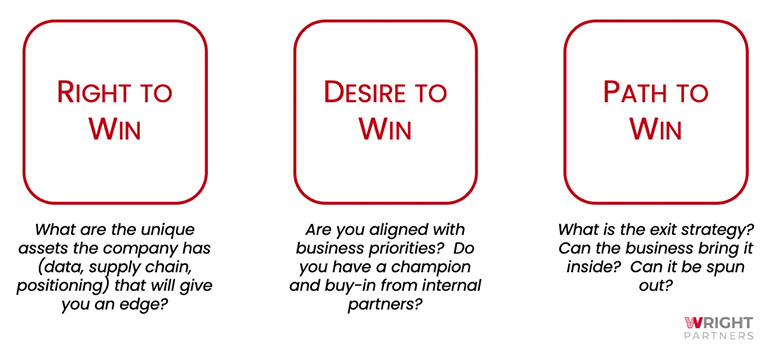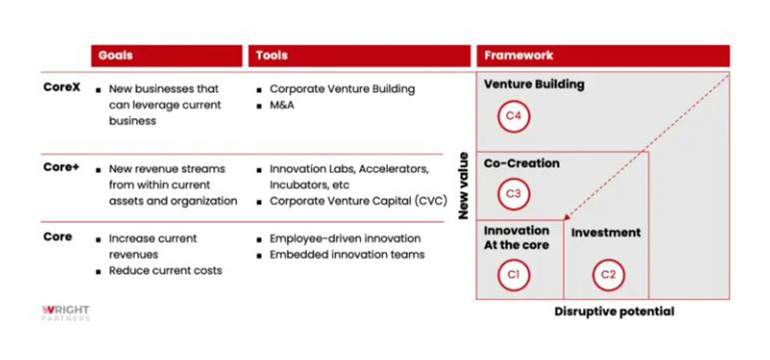Formal Governance
Converting these informal support networks into formal governance is crucial for long-term success but should be done carefully and only as needed. Placing too much bureaucracy and reporting onto innovation processes can hamper or even kill them. At Wright Partners, we advise our clients not to create huge innovation programs, which often require substantial time and money upfront, before any innovation has started and long before the corporate knows if it’s the right process for them. Instead, we emphasise creating small groups of empowered executives to make decisions and manage risks, scaling up the number of innovation initiatives over time.
When formal governance is implemented, it should focus on managing risk while promoting speed and learning. Innovation champions or sponsors should meet regularly with their teams, review milestones, and be empowered to access resources and provide support. A more formal committee of executives can then be tasked with making major investment decisions, managing risk appetite, and reviewing the alignment of strategic priorities.
Wright Partners is currently working with a global bank where our venture presents to a formal investment committee twice a year to report on milestones, request the next 6 months of funding, and propose the next set of milestones and funding requirements. This ensures continuous alignment on priorities, goals, and potential risks while giving the venture the ability to propose relevant milestones and space to freely drive the business in the intervening months.
4. Nurturing Optionality Gives Flexibility
Having the right governance structures and metrics in place will help ensure the relevance of a company’s innovation portfolio, but to be able to drive successful outcomes, especially farther out on the innovation horizon, a company has to maintain flexibility in its approach in order to create what Wright Partners calls “optionality.”
Venture Hypotheses not Corporate Strategies
Corporates can no longer afford to spend months (and often millions of dollars on consultants) to create static, long-term Corporate Strategies. Even before the pandemic, the value of a 5-year strategy was being questioned and today there is more pressure than ever to build dynamic plans that can address high market uncertainty. This means that companies have to remain flexible in how they support and grow innovations. They have to allow a certain level of freedom when setting goals for outside-the-box innovations, especially new ventures. In turn, these ventures need to stay focused on proving a hypothesis for market demand rather than chasing ever-changing corporate strategies. This approach can create short-term gaps between a venture’s goals and the company’s strategy but, by maintaining optionality, the company can support the new venture in a way that adds the most value.
Which Way to Spin
Given the dynamic nature of corporate strategy and the speed at which ventures have to adapt, companies need to create space where these ventures can grow and demonstrate whether they can drive internal value or are best placed as external endeavors. In our experience, this means creating as much space as possible for a spin out and avoiding the premature assumption that they can be spun in as a new business unit. This bias towards spin out is driven by a few key observations:
- Over-Valuation — Internal ventures are often given ample space to play, which can give them extra time to find market fit, but can also result in over-investment by the corporate. In these cases, a company can often over-value the money and time spent on exploration creating an inflated valuation when they decide to seek external funding. Meanwhile, external investors look only at the traction achieved and may be unwilling to match these excessive valuations.
- Lack of Founder Incentives — Innovations are most successful when everyone’s incentives are aligned. For ventures, this means giving the founding team a meaningful stake in the business (something that external investors look for). However, if a company has already over-invested in an idea, “giving” an equity stake to the founders as part of a spin-out can appear like a substantial loss in value.
- Political Risk — If a venture has been supported as a potential new business unit, it is much harder to spin it out. Most likely, there has been substantial political capital spent to frame the innovation as a “strategic investment.” As a result, the venture coasts along as a “zombie venture” that is never given the space to scale or die like most new businesses.
Always Spin Out?
No! However, at Wright Partners, we believe in building corporate ventures with the intention that they will be spun out. We find that this gives the venture the right pressure, tension, and momentum while providing optionality to the corporate to spin in the venture once it is ready. The reasons are very simple and anchored in the basics of corporate finance, which we have explored in earlier articles. Money today is better than money tomorrow, hence limiting the corporate’s spend early, and potentially taking over the venture later is a more efficient use of cash. In addition, this optionality ensures that the venture either aligns with the corporate strategy over time OR remains as an outside venture supporting the corporate (which we often see as a relevant option).
Desire to Win in Corporate Venture Building
The Desire to Win is critical for any innovation endeavor. However, for initiatives farther out on the innovation horizons, it is even more important and more difficult to build and maintain that desire. As a result, Wright Partners has embedded the principles discussed above in every step of our process:
- Strategic Alignment — Given that Venture Building is focused on areas of high uncertainty, we spend a substantial amount of time before finalising a mandate to understand how venturing fits with a partner’s overall strategy and risk appetite. We have developed a Venture Building Assessment for corporates to help them understand the key elements required for success. We also align on how an independent venture will be structured, ensuring they have the optionality to spin in or even stop the venture.
- Relevant Metrics — Our design and build phases are built on 2-week sprints with concrete milestones and deliverables at the end of each sprint. These milestones are tailored to the stage of the venture and focused on demonstrating the potential for the solution and how it will deliver value.
- Formal and Informal Governance — We identify key sponsors and agree on governance structures and timelines as part of our early conversations with corporate partners, often before we have even formally won the mandate. In keeping with our philosophy on lightweight and outcome-focused governance, we generally recommend a Venture Board that is driven by our sponsor and meets with the team every two weeks to ensure rapid progress and continuous alignment. We also support the creation of a more formal Investment Committee that is composed of executives with the ability to make major investment and risk decisions but only meets every few months to review major milestones.
- Optionality — This is one of our core values, as we believe that creating optionality for corporations allows them to build better while maintaining choice and limiting expenditure. This ensures that the decision on spin out (take external investment) or spin in (pay off the founding team for success) happens when the strategy of the corporate and traction of the venture align and not before.
Ultimately, the Wright Partners model is focused on managing risks while giving the venture the freedom to move and learn quickly.
In Summary…
Many corporates still struggle to drive effective innovation, largely because they don’t answer three key questions — do we have the Right to Win, the Desire to Win, and the Path to Win? In this article, we focused on that second question:
- Wanting to innovate isn’t enough, your organisation must have a Desire to Win — This means innovation should be a core part of a company’s business strategy and embedded in success metrics
- Building and maintaining a desire to win requires managing four key areas — Strategic alignment between the business and innovation initiatives, relevant metrics that focus on impact not vanity, formal and informal governance that accelerates innovation rather than hamper it, and optionality that provides multiple paths forward
- The Wright Partners approach starts building the Desire to Win even before we secure a mandate — we leverage a lightweight, outcomes-driven model that addresses each of the four areas of alignment
This is the second in a three-part series. In our previous post, “The Right to Win” we focused on how to identify and leverage true unfair advantages when creating new products, business models, and ventures.
This article was written by Stefan Jacob, Venture Partner; and Ziv Ragowsky, Founding Partner; at Wright Partners.
Wright Partners (in partnership with MING Labs) is an appointed venture studio of EDB’s Corporate Venture Launchpad programme enabling companies to incubate and launch a new venture from Singapore.
Through the programme, participating companies can look forward to partnering with EDB New Ventures, the corporate venturing arm of EDB, and an appointed venture studio with corporate venture building expertise and experience, to nurture their venture concepts and scale for success.









